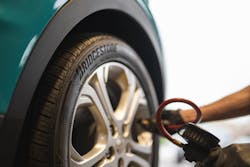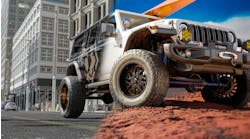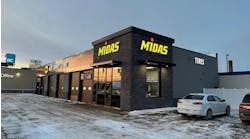Like the vehicles they carry and the consumers who buy them, tires are constantly evolving. (Remember when radials were the next big thing?)
“Innovative tire technology is required to continue delivering a safe, smart and efficient transportation experience,” says Will Robbins, director of consumer product strategy, Bridgestone Americas Inc.
MTD recently asked tire manufacturers, “What’s the next tire technology that will become standard on consumer tires?” Some of their answers might surprise you. (Responses to the above question are attributed to representatives from those companies when provided.)
Will Robbins, director of consumer product strategy, Bridgestone Americas Inc.: The essential function of tires to deliver safe and efficient performance will remain unchanged, but the megatrends of connected, autonomous, shared and electric technologies are resulting in unique demands being placed on tire technology — not only in performance, but as a driver for environmental improvement.
Probably the most immediate impact in tire design and technology will come with the continued adoption of electric vehicles (EVs). As EVs become more prevalent, tire design is shifting to support unique design elements, such as increased overall weight, higher torque, regenerative braking, the need for extended range and a quieter ride. Therefore, much of the design innovation for tires on electric vehicles is focused on load carrying capacity, improved rolling resistance to extend range and optimized tire designs to reduce noise in the cabin.
In the case of connected and autonomous, we are continuing to design and develop tires that will be smarter through technologies built into the tire to assist the vehicle.
As the only portion of the vehicle connected to the road, the tire has the unique ability to deliver valuable information to the vehicle in real-time as road or tire conditions change. As these vehicles become more prevalent, it will require this important shift in tire design and technology to ensure drivers are safer and moving more efficiently.
Continental Tire the Americas LLC: Continental is focusing on tires that are both sustainable and technological. The result — a tire that consists of a particularly high percentage of traceable, renewable and recycled materials; has an innovative, lightweight design that conserves valuable resources; and extended service life, thanks to a renewable tread.
The tires are purpose-engineered for the future’s sensor-equipped, smart vehicles with eco-friendly drives.
The concept study for this tire underscores our commitment to fully switching production to raw materials from sustainable sources. The Conti GreenConcept is made with more than 50% sustainable raw materials.
The Conti GreenConcept also consists of 17% recycled materials, namely reclaimed steel and recovered carbon black, plus — in an industry first — polyester from recycled plastic bottles for the tire’s casing.
The materials used in the tread were also optimized, thus further reducing the tire’s weight and, in turn, lowering rolling resistance.
David Shelton, director of industry relations, Giti Tire (USA) Ltd.: The connected vehicle is in full swing. As the newer vehicle is more computerized and loaded with more sensors and then connected through the internet to supercomputers, there will be a continuation of interconnectivity and data communication for the performance of every working part on the vehicle.
Tires will be constantly monitored for effectiveness and condition. A great deal of data will be generated and monitored regarding how the vehicle is navigating the roadways, terrain, geography and climate, as well as driving conditions and responses to the conditions.
Will we see chips in each tire cavity be able to note air pressure, load, temperature and shock/impact force? Radio-frequency identification (RFID) tags are already in some tires and may soon be in all tires as identifiers of the tire, make, model and size. However, since tires are one of the few consumables on the vehicle, it stands to reason that most of the monitoring sensors will be part of the vehicle rather than the tire.
There is a major effort, of course, toward electrification of passenger, light truck and commercial (truck and bus) vehicles. Electrification will bring with it some temporary, as well as long-term shifts, in targeted tire design requirements.
In the short term, there are two initial concerns, especially for other than urban use. One is the range of the vehicle between charging, so rolling resistance of tires is a big consideration. With that reduction in rolling resistance, the trade-off is usually grip — primarily wet grip — and/or tread life. Innovation must be developed to expand the current performance capabilities.
The second concern for electric vehicles is gaining range, which requires stronger — and bigger — battery packs, which adds weight. This may require a tire with a higher load carrying capacity.
Additional factors with electrification include a low-noise tire. Without the sounds of the internal combustion engine, the road and pattern noise become much more apparent to both those in the vehicles and those near the roadway.
Tires must also deal with the higher torque the electric motor typically delivers, which may accelerate tire wear, so traction control systems — and potentially tire characteristics and compounds — must be employed to meet consumer expectations.
Circling back, the industry is working through automated driver assistance systems and heading into the mapping of everything toward the autonomous vehicle.
Josh Simpson, senior vice president, proprietary brands, Hercules (American Tire Distributors Inc.): Hercules is always looking for emerging trends as we develop our consumer product line, so we remain strategic while retaining dealer profitability.
Brandon Stotsenburg, vice president, automotive division, American Kenda Rubber Co. Ltd. We have focused on the larger and faster-growing segments that can demonstrate our value — ultra-high performance A/S, grand touring, premium, speed-rated CUV and SUV and, more recently, the light truck segments like A/T and the expanding R/T segment.
Light truck owners are often more discerning and do significant research to confirm that their tires reflect the performance needs, aesthetic concerns and their individual personalities.
Kenda sees North American growth in the fast-growing CUV, SUV and light truck segments and continues to add sizes to offer the consumer options for first replacement.
We anticipate that the light truck segment will remain strong for growth, but there will be increasing demand in two areas.
Number one, increasing electric and hybrid applications will change some of the performance elements for those vehicles. There will be additional needs for rolling resistance and performance — driven by torque differences — in most current applications. Regional fleet growth will have different priorities for performance, as well. Kenda has been over-indexing with our Klever H/T2 KR600 tire for fleets like Amazon that need strong performance, but need to measure effectiveness based on cost/mile.
Second, all-weather applications will find a stronger position as engineering offers balanced solutions for wear in North America, combined with 3-Peak Mountain Snowflake certification and wet/dry performance.
It has been difficult to find carcass and materials answers without giving up significant performance attributes that North American consumers demand. For example, traditionally it has been difficult to provide good, predictable wear when also offering 3-Peak Mountain Snowflake certification.
Russell Shepherd, technical communications director, Michelin North America Inc.: Tires are now being equipped with RFID and other electronics. This technology will instantly allow tire manufactures, original equipment manufacturers and tire dealers to modernize the supply chain process by tracking tire inventory and usage wirelessly and almost instantly.
RFID and similar technologies will allow tire information to interact with vehicles and directly with consumers and open the door to adding value to tires through apps and services.
Aaron Neumann, manager, product development, Nexen Tire America Inc.: Most research and development resources go into incremental improvements in tire performance that consumers don’t realize they are getting.
Now you can buy tires with very high levels of snow performance that also deliver good wet and dry performance. You can leave them on your vehicle all year round. A lot of high-level R&D went into achieving that level of performance.
I personally would like to see a labeling system on tires sold in the United States — similar to what Europe and other countries have adopted — to help consumers choose tires based on actual tire performance and not marketing.
This would help consumers avoid poor-performing tires. But this would need to be driven by the National Highway Traffic Safety Administration and there is not a strong push right now.
We are also working on technology that will inform the driver when a tire is worn-out or has damage. This is more sensor technology than tire technology and I expect it will be a few years before consumers will see it on new cars.
Steve Bourassa, director of products, Nokian Tyres: As electric and hybrid vehicles become more popular with North American drivers, tiremakers must introduce products that respond to the unique needs of eco-friendly vehicles.
Electric and hybrid vehicles are typically heavier and quieter than those with combustion engines and their drivers demand predictable efficiency in order to maximize the range between charges.
Nokian Tyres embraces the opportunity to serve as an industry leader in this area. This winter, we are introducing the Nokian Hakkapeliitta 10 EV, our first winter tire built specifically for electric vehicles.
We continue to explore other opportunities to cater to the needs of EV drivers, as we believe this emerging audience will only continue to grow.
Pirelli Tire North America Inc.: First, green tires — (including the) increased use of recycled / recyclable materials, as well as sustainable sources — all focused on making products with lower rolling resistance.
Pirelli has become the first company in the world to produce a range of Forest Stewardship Council (FSC)-certified tires designed for the BMW X5 xDrive45e Plug-in Hybrid.
These tires contain FSC-certified natural rubber and rayon and represent a new horizon for increasingly sustainable tire production. The new tire is produced exclusively at Pirelli’s Rome factory in Georgia.
Secondly, connected tires — the sensorization of tires connecting tires to the vehicle for safety and performance, as well as integration of tires in the total vehicle management system, including maintenance.
Pirelli has been the first tire company in the world to transmit information detected by intelligent tires regarding the road surface via the 5G network.
Furthermore, for the first time, Pirelli has equipped as standard a tire with sensors that can talk to a car. Pirelli’s Cyber Tire system (is) made up of a sensor in each tire that gathers vital data for safe driving, linked to software integrated into the car’s onboard computer.
Cyber Tire technology offers a plethora of information to the car and driver: the tire’s “passport” —the type of tire, whether it’s a winter or summer version, (plus) prescribed pressure, load index and speed rating — as well as current running information, such as temperature and pressure.
Nick Gutierrez, sales director, Sentury Tire USA: From the beginning, Sentury has always focused on technology.
We continue to focus on eco-friendly manufacturing and sustainability to our “Industry 4.0” smart factory standards.
We take pride in our core values and product quality. We insert our standards into all of our projects, just like our recently completed second phase factory expansion in Thailand.
Jenifer Golba, senior vice president, consumer product marketing, TBC Corp: With the recent investments by vehicle manufacturers, the evolution of consumer attitudes and increased government regulations, the projection for EVs continues to grow. EVs are the future.
As EVs become standard, certain tire technologies will become important to optimize EV range and enhanced driving performance.
Due to the higher torque and heavier weight of EV vehicles, tire compounds and tread patterns will be adjusted to handle these vehicles.
For a smooth, quiet long-lasting ride, EV tires will also need to be designed to reduce rolling resistance and include a sound dampening component to minimize tire noise.
Andrew Hoit, vice president of sales and marketing, Tireco Inc.: I do not foresee any revolutionary technology developments in the near future.
I do, however, believe we will see more and more manufacturers focus on improvements in compounding to continue enhancements surrounding low rolling resistance initiatives and the EV segment.
I expect to see multiple manufacturers develop EV-specific product lines in the coming years that combine the rolling resistance improvements with the additional load requirements necessary for the added weight of EVs.
Drew Dayton, senior product planning manager, Yokohama Tire Corp.: Tire technology is constantly being improved to increase performance, while minimizing trade-offs. The automotive industry’s focus on fuel efficiency is expanding even more with the widespread introduction of EVs.
Future EV-specific replacement tires are likely to become more prevalent and will likely push the limits of increasing range and wear, while maintaining the wet and dry performance.
New processes, facilities and more: Tire manufacturers adapt in face of shipping challenges
The ongoing shipping crisis continues to impact both tire manufacturers and tire dealers. How are tiremakers helping to ensure good fill rates for their customers?
“We continue to monitor challenges in the supply chain very closely and so far we have not seen any significant impact to our business,” says Will Robbins, director of consumer product strategy, Bridgestone Americas Inc.
“Bridgestone is fortunate to have a diverse supply chain that includes both domestic and global manufacturing. There are challenges for sure and supply is tight, but we are confident in our ability to meet our customers’ needs.”
Josh Simpson, senior vice president, proprietary brands, for American Tire Distributors Inc., says, “We’re not immune to delays from overseas and shipping challenges, in general. There have been delays for all manufacturers that are importing products into the U.S. due to shortages of containers and extended lead times. However, we continue to work through them and provide our dealers with products.”
John Hagan, executive vice president of sales for Nexen Tire America Inc., says Nexen is “looking for the best possible ways to get tires to our customers every day in the most economical way possible.”
Christy McDaniel, head of supply chain for Nokian Tyres plc’s North American business, says the “steady increase in domestic production at our North American factory in Dayton, Tenn., has helped us reduce our reliance on global supply. And the facility will especially pay dividends once it reaches full capacity in the coming years.
“The factory also reduces shipping lead times and allows us to align production with North American demand.”
Nokian recently moved to an expanded distribution center in the Chicago, Ill., market “to better accommodate the rising domestic volume we’re seeing” and is planning to set up a new warehouse at the company’s Tennessee plant.
Pirelli Tire North America Inc. officials characterize shortages and supply chain disruptions as “significant. Pirelli is working closely with customers on an integrated approach to ensure that they are prepared in this environment.
“We are using levers — such as collaborative forecasting, made-to-order productions and stock data sharing — to maximize availability and sales.
“In order to evade inflation and high terminal congestion on local distribution, we have combined the approach with customers based on delivery optimization and a cost-saving sharing model to not compromise premium service.”
“It seems as if logistics, in general, are continuing to get more and more difficult,” says Nick Gutierrez, sales director, Sentury Tire USA. That includes securing space on vessels “at competitive rates
“Lots of contracted rates continue to exist, but are being outweighed by spot market purchasing. We continue to fulfill our business partners from factory-direct and work together on current container shipping options. We also have two U.S. warehouses that help fill current and future voids.”
Jenifer Golba, senior vice president, consumer product marketing, TBC Corp., says TBC’s portfolio of domestically and internationally produced products allows “for a minimized risk of supply disruption. We have also proactively taken additional actions to assist with the reduced fill rates, such as improved days of sales coverage, increased order frequency, targeted, high-volume SKUs” and streamlined forecasting.
“In March, we launched a logistics intelligence system that provides access to more inventory through different points of distribution, offering our customers visibility to more tires.
“Recently, we launched a just-in-time delivery option to meet our dealers’ demand of increasing SKU complexity and speed, offering delivery within two hours or less for dealers in a 35-mile radius. We have also increased our collaboration with dealers providing digital integration.”
Tireco Inc. is using its network of distribution centers “and longstanding relationships with our overseas carriers to optimize our product flow to best support our customers,” says Andrew Hoit, the company’s vice president of sales and marketing. “We expect the next nine months to continue to be challenging, but we are confident in our partners and our ability to provide” optimal fill rates.
Joaquin Gonzalez Jr., president, Tire Group International LLC (TGI), says the “reality is (that) no one could have anticipated the escalation of freight rates — as well as the shortage of equipment — we are facing.
“Freight rates are up over 500%, and the most frustrating part — even if you pay the market rate for certain lanes — is you are not guaranteed a booking. In my 25-plus years in the business, I have never seen anything like it.”
TGI is dealing with the situation “as best we can. We prioritize shipments, as well as find alternate lanes that may provide additional booking confirmations. We have also increased our inventory reserves at all our distribution centers to have better availability as transit times become longer.”
Brian Fjeldsted, vice president of marketing at Vogue Tyre & Rubber Co. says Vogue, “like many in the industry, (is) faced with shipping and logistics challenges. We are facing these challenges by being as transparent and accurate in our communications with our customers.
“We have established new processes and ongoing reporting to better forecast when products will be available, so that our customers can better manage their clients’ expectations. Our regional managers are having, at a minimum, weekly conversations with our wholesale partners on product shipping updates.
“Finally, internally, we have better organized our warehouses and procedures to turn products as fast as possible to our customers.”
“In the dynamic situation of ever-evolving challenges for worldwide logistics, we are focusing on increasing communication with our customers to keep their priorities at the forefront,” says Drew Dayton, senior product planning manager, Yokohama Tire Corp.
“Our logistics team is investigating every opportunity to maintain our supply from factory to customer in the quickest, most efficient manner. That’s why we just opened our fourth distribution center in the U.S., a new 430,000 square-foot facility in Wilmer, Texas.” The warehouse is located 15 miles from Dallas.




